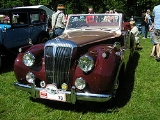
Daimler Regency
Encyclopedia
The Daimler Regency was a luxury car made in Coventry by the British Daimler Motor Company between 1951 and 1956. Announced at the October 1951 Motor Show it was a 3 litre derivative of the 2½ litre DB18 Consort.
The car was made in two versions, the Regency and the Regency II. The Empress, bodied by Hooper, was the super-luxury version. Only 52 examples of the Regency I were made before production stopped in early 1953.
The revised II model came out in October 1954, slightly longer and lower and it could be supplied with a 4.6 litre engine.It was little more successfuI and was superseded in late 1955 by the One-O-Four model which was again little more than a variant with a more powerful engine.
A pre-selector 4 speed gearbox was fitted coupled to the engine by Fluid Flywheel.
Automatic chassis lubrication was fitted.
The brakes on the Regency were a Girling hydro-mechanical hybrid but this changed to fully hydraulic set up on the Regency II
Worm and double roller steering was used.
.
The bodywork on the Regency II was stylistically very similar to the earlier car but with a longer tail allowing a larger boot. Again there was a Hooper version, the Empress IIa and III but now also the Sportsman four light saloon with coachwork by H J Mulliner
.
magazine tested a 3468 cc Regency II saloon in 1955 recording a top speed of 82.8 mph (133.3 km/h) and acceleration from 0-60 mph (96.6 km/h) in 22.7 seconds and a fuel consumption of 15.7 mpgimp. The test car cost £2324 including taxes.
The car was made in two versions, the Regency and the Regency II. The Empress, bodied by Hooper, was the super-luxury version. Only 52 examples of the Regency I were made before production stopped in early 1953.
The revised II model came out in October 1954, slightly longer and lower and it could be supplied with a 4.6 litre engine.It was little more successfuI and was superseded in late 1955 by the One-O-Four model which was again little more than a variant with a more powerful engine.
Engine and transmission
The range was launched with a six cylinder 3 litre (2952 cc) 90 bhp engine. This was supplemented in 1952 by an enlarged 3468 cc version. The Regency II had a choice of the 3468 cc or larger 4617 cc six. All these engines were based on the same basic design seen previously as a four cylinder in the Lanchester 14.A pre-selector 4 speed gearbox was fitted coupled to the engine by Fluid Flywheel.
Chassis, and running gear
The chassis was made of box section steel and was cruciform braced going over the rear axle. The suspension was independent at the front using coil springs but retained traditional leaf springs and live axle at the rear.Automatic chassis lubrication was fitted.
The brakes on the Regency were a Girling hydro-mechanical hybrid but this changed to fully hydraulic set up on the Regency II
Worm and double roller steering was used.
Coachwork
The standard body for the Regency was a four door, six light (3 windows down each side) saloon made by Barker who were Daimler owned. In 1952 it was joined by a convertible and the Empress II with razor-edge styling by HooperHooper (coachbuilder)
Hooper was a British coachbuilding company based in London.-Founding:The company was founded as Adams and Hooper in 1805 and held a royal warrant from 1830, building elegant horse drawn carriages, supplying them to King William IV, Queen Victoria and King Edward VII. The first royal car, a Hooper...
.
The bodywork on the Regency II was stylistically very similar to the earlier car but with a longer tail allowing a larger boot. Again there was a Hooper version, the Empress IIa and III but now also the Sportsman four light saloon with coachwork by H J Mulliner
H. J. Mulliner & Co.
H. J. Mulliner & Co. was a well-known British coachbuilder operating at Chiswick in West London.The Mulliner family can trace their coachbuilding history back to 1760, building coaches for the Royal Mail in Northampton....
.
Performance
The British MotorThe Motor (magazine)
The Motor was a British weekly car magazine founded on 28 January 1903....
magazine tested a 3468 cc Regency II saloon in 1955 recording a top speed of 82.8 mph (133.3 km/h) and acceleration from 0-60 mph (96.6 km/h) in 22.7 seconds and a fuel consumption of 15.7 mpgimp. The test car cost £2324 including taxes.

